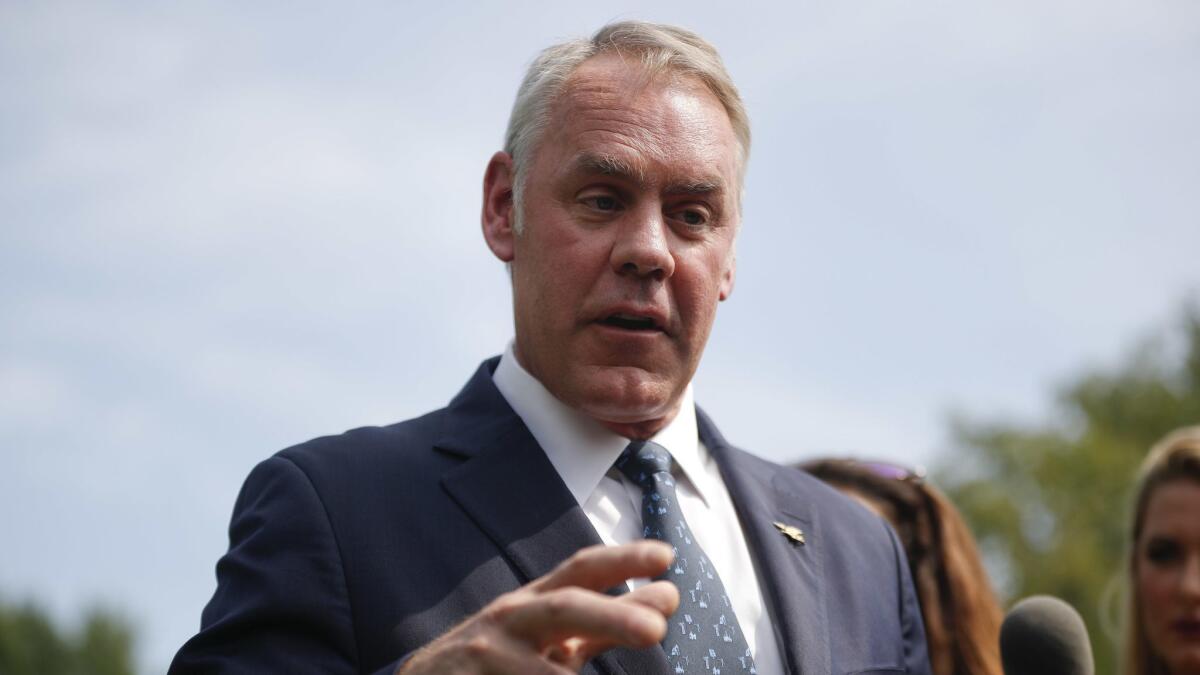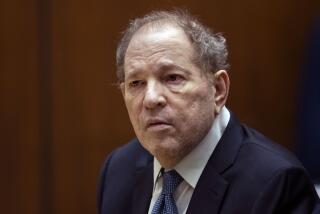Column: Ryan Zinke, Trump’s Interior secretary, fires another shot at California water policy

Interior Secretary Ryan Zinke, stepping up the Trump administration’s attack on California water policy, on Friday issued a memo to his staff demanding a “plan of action” to circumvent state officials. He gave the staff 15 days to develop a proposal and present it to his deputy, a former lobbyist for big water users at odds with the state.
Zinke’s memo represents the latest volley in a developing war between the Trump administration and the state over the distribution of water from state and federal projects. The administration has been pushing for more water deliveries to Central Valley farmers, many of whom are in districts that delivered votes to Trump in the last presidential election — even though the state as a whole voted for his Democratic opponent, Hillary Clinton.
The time for action is now.
— Interior Secretary Ryan Zinke
Zinke instructed the staff to produce an action plan aimed as “maximizing water supply deliveries,” in part by “streamlining” consultations related to the Endangered Species Act, “better incorporating best science” into Interior decisions, constructing new water storage, and making infrastructure changes to “independently operate” the federally funded Central Valley Project.
Many of those initiatives would run counter to state policy. The state Water Resources Control Board is holding a two-day public hearing starting Tuesday on its own plan to increase water flows to the state’s rivers to protect fish and fisheries. Zinke referred to those plans as proposals for “additional unacceptable restrictions” that would reduce his agency’s ability to deliver water to growers and urban users in Central and Southern California.
“The time for action is now,” he exhorted his staff. He called for both proposals for Congressional legislation and preparation for litigation, presumably against the state.
Experts in the environmental laws governing state and federal water policy in California viewed the memo as intensifying the intergovernmental confrontation. “It’s indicative of a more bullying and hysterical tone,” said Doug Obegi, director of the California water program at the Natural Resources Defense Council.
Obegi said the memo signaled the government’s intention to “gut environmental protections” in the Sacramento Delta, from which water is pumped to serve Central and Southern California users. But he also took its overheated tone as “a sign that the state has been fairly effective at pushing back.”
Zinke’s reference to “new water storage” is probably a reference to a proposal to raise the height of Shasta Dam to increase the capacity of its reservoir, Lake Shasta, which is opposed by the state.
Zinke’s reference to his desire to “independently operate” the Central Valley Project might conflict with federal law, which generally requires the federal government to comply with state policies, even on federally funded water projects.
The plan of action is to be submitted to Interior Deputy Secretary David Bernhardt, a former lobbyist and attorney for water users who might benefit from the initiatives Zinke ordered, including the vast Westlands Water District in the Central Valley.
By directing staff to report directly to Bernhardt, Zinke placed the former lobbyist at the center of the battle over water rights, despite his potential conflicts of interest.
Bernhardt, whose obligation to recuse himself from decisions affecting his former clients has expired, recently published an op-ed in the Washington Post advocating changes in the Endangered Species Act that could steer more water to Central Valley growers at the expense of fish and fisheries.
Other Trump administration figures have also taken steps to undermine state policies. Commerce Secretary Wilbur Ross this month ordered agencies under his jurisdiction, including the National Marine Fisheries Service, to circumvent the Endangered Species Act on the pretext that water deliveries blocked by ESA rules were needed to fight California wildfires — an assertion contradicted by fire officials. Trump made the same claim in a tweet that was widely derided as nonsensical and uninformed.
Last week, meanwhile, Zinke claimed in an interview with the right-wing Breitbart News radio service that “environmental terrorist groups” are largely responsible for the severity of the fires. Fire scientists and forestry experts say that the main factor in the increasing intensity of wildfires in the West is climate change.
Keep up to date with Michael Hiltzik. Follow @hiltzikm on Twitter, see his Facebook page, or email michael.hiltzik@latimes.com.
Return to Michael Hiltzik’s blog.
UPDATES:
5:52 p.m.: This post has been updated with comments from Doug Obegi of the NRDC.
More to Read
Start your day right
Sign up for Essential California for news, features and recommendations from the L.A. Times and beyond in your inbox six days a week.
You may occasionally receive promotional content from the Los Angeles Times.







